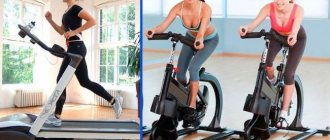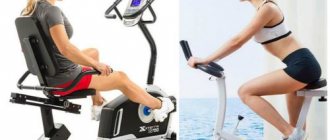Exercising on a treadmill is an excellent cardio exercise that warms up and strengthens muscles, stimulates the respiratory system and develops endurance. Now almost all gyms and fitness centers are equipped with treadmills, but, you see, it’s much more convenient when you have such a universal exercise machine at home. This article is intended for those who want to run at home, but have not yet understood the many types of treadmills, their design features, advantages and disadvantages.
How does a manual treadmill work?
A mechanical treadmill is the simplest and cheapest type of exercise machine , in which the load is set only by the weight of the athlete and the friction force. In the simplest mechanical tracks, the only adjustable element is the angle of inclination of the canvas - the greater it is, the more difficult it becomes to run. More advanced models include a brake shaft that acts on the blade with a force controlled by a special screw or handle.
Advantages of mechanical tracks:
- cheapness;
- small size and weight;
- Full autonomy (do not depend on electricity).
The disadvantages of the mechanical type of simulator include:
- lack or minimum of additional functions;
- inability to accurately adjust the load;
- movement of the canvas in jerks;
- dependence of the speed of movement of the belt on the degree of fatigue of the athlete;
- excessive stress on the joints.
Mechanics, magnets and electronics
Treadmills are available in mechanical, magnetic and electric types.
The operation of a mechanical cardio machine does not depend on power supply and is based on the efforts of the athlete. The faster the athlete runs, the faster the belt rotates. Mechanical models are the simplest type of treadmill; they are bought for home training.
There is also professional “mechanics” that is installed in functional training halls. The simulators are equipped with additional parameters - load levels, inclination of the belt, and the presence of belts. An example of a mechanical track is the S-DRIVE Performance Trainer.
The average price for a mechanical treadmill is from 9,000 to 15,000 thousand rubles, a functional training track is from 250,000 to 600,000 thousand rubles.
This simulator is installed in functional training rooms to develop explosive strength power.
The magnetic track is based on the same principle of operation as the previous “brother” - at the speed of the runner. This type of cardio exercise machine is equipped with a magnet, which is responsible for regulating the movement of the belt. The advantages of this equipment are the functional display and smooth operation without jerking. Budget models are purchased for home workouts, “advanced” models are purchased for commercial use in small fitness centers.
The average price tag for a magnetic track ranges from 15,000 to 40,000 thousand rubles.
The electric treadmill is powered by a motor, which sets the running belt in motion. This subtype of cardio is characterized by a smooth ride and a display that adjusts the running speed, incline, sets the training mode and contains special training programs. The on-board computer of premium treadmills has a built-in sensor, Internet access, and Google Fit and Apple applications.
Electric treadmill price suitable:
- for home – from 10,000 to 200,000 rubles,
- for fitness centers with low traffic – from 100,000 to 300,000 rubles,
- for fitness centers with high traffic – from 300,000 to 2,000,0000 rubles.
This machine is designed for everyday, high-impact workouts.
The simulators are designed for professionals and daily intensive training. Therefore, treadmills have impressive dimensions and a high safety margin of components. Such equipment is installed in fitness centers. Examples of professional exercise machines are VISION T60, BRONZE GYM T1100 PRO, Matrix T1X (T1X-04).
Engine characteristics and power
The capabilities of the motor affect the cost of the electric track. Thus, home exercise equipment with a DC motor costs an order of magnitude lower than commercial equipment equipped with an AC motor. Durable AC motor withstands intense workouts.
Thanks to this engine, it is convenient for an athlete of any weight and performance to exercise on the simulator.
Engine power is measured in horsepower. The power of home treadmills varies from 1 to 3 HP. p., professional - from 3 l. With. and higher. The speed of the web also depends on this indicator. On mechanical and magnetic treadmills the speed can be reached up to 12 km/h, on electric ones – up to 20 km/h.
Some models with a powerful motor are equipped with a cooling system. This function protects the machine mechanisms from overheating and breakdowns.
What does "magnetic treadmill" mean?
It was possible to get rid of some of the shortcomings of mechanical treadmills by using a magnet as a braking element. To understand the difference between mechanical treadmills and magnetic ones, you need to analyze the nature of the movement of the belt. In a simple mechanical scheme, the runner, pushing off from the canvas with his feet, moves it back a certain distance, and the opposing frictional force stops this movement as soon as the force of the push subsides. The magnetic brake does not interfere with the movement of the belt , but only slows it down, which ensures smooth running of the belt and comfortable running. Let’s systematize the advantages of a magnetic treadmill in order to understand which treadmill is better, mechanical or magnetic:
- smooth ride;
- no mechanical wear of the brake;
- reduction of mechanical wear of the blade;
- quiet operation;
- compactness and autonomy.
However, some design flaws remain:
- Load adjustment is even more difficult;
- still a minimum of additional functions;
- the speed, as in a mechanical track, depends on the fatigue of the runner.
As we can see, a magnetic treadmill is more advanced than a mechanical one , although it is not without some significant drawbacks.
Now that you know what a “mechanical treadmill” means and what a “magnetic treadmill” means, let’s move on to the most modern and advanced type of exercise machine – the electric one.
How to choose a treadmill for your home so that it doesn’t become covered in dust in a month.
From the above, you can already draw some conclusions, but now I will try to systematize everything.
1. Decide on the size of the track. The taller you are, the greater the length and width of the canvas should be. If the length is insufficient, you will not be able to take wide steps, and if the canvas is too narrow, you can get injured by stepping on the side instead of the canvas. If several people will be engaged, then you need to choose the largest one.
2. Decide what features you need. If you only need a treadmill for those rare occasions when you don’t have time to get to the gym, then take a simple mechanical one. If a home exercise machine will be your main load, then you should look at an electric one with the ability to set different training programs.
3. Select engine power (for electric). The basis for selection is two parameters: weight and running speed. The larger they are, the greater the power should be.
4. Consider cushioning and the need for heart rate monitoring.
5. Foldable or not
If you decide that you need to take a folding one, then pay attention to the presence of shock absorbers - they will eliminate the possibility of a sudden lowering of the canvas
6. Before choosing a treadmill for your home, be sure to read reviews of brands that interest you. You can read some reviews on this page (coming soon)
, also actively use the forums.
7. Before purchasing, find out information about the warranty and service work. Ask the seller how long you will have to wait for repairs if the track suddenly fails.
8. Be sure to test several options you like. I read somewhere that you need to start testing with the most expensive product in the store (supposedly then you can feel the difference better). When testing, do not waste your time; in 30 seconds you will definitely not be able to feel all the pros and cons.
And in conclusion, I suggest you watch an interesting video about choosing a treadmill. Be sure to watch it to the end!
Electric treadmill for home
The main difference between a mechanical treadmill and an electric one is that the latter is driven by an electric motor , which sets the force, speed, inclination angle and other parameters. Most often, electric treadmills are equipped with a microcomputer, whose responsibilities include creating and maintaining training conditions that are right for you. Most microcomputers also work with pulse, temperature, and pressure sensors, which allows you to monitor the state of the body while running, calculate the intensity of exercise and calories burned.
Electric treadmills, in turn, are divided into three classes:
- Economy class , including inexpensive tracks without tilt angle adjustment, power up to 5 kW and speed within 2-15 km/h.
- Amateur class - the power of such tracks is 5-8 kW, the speed range is 1...20 km/h, electronic adjustment of the slope angle and training programs stored in the microcomputer memory are added. The canvas of such paths is usually slightly wider than that of economy class paths, sometimes up to 50 cm.
- The professional class includes powerful, high-quality treadmills, often equipped with brushless motors and designed for many hours of daily use in gyms, fitness centers, and rehabilitation medical institutions. Their power can reach 12 kW, and the maximum speed is 40 km/h (for training professional athletes). Many of these tracks have the function of flexible program changes depending on temperature, pulse and other indicators of the body’s condition.
As we can see, mechanical and magnetic treadmills differ from electric ones in that they significantly limit the athlete in the choice of training modes, comfort of training and reliability.
Advantages of electric treadmills:
- smooth ride;
- uniformity and constant load;
- easy and precise adjustment of all parameters;
- the presence of built-in programs and the ability to create them independently;
- full control over your health during training;
- high reliability and durability of mechanisms;
- convenience and ease of use.
Disadvantages of electric treadmills:
- large size and weight;
- high energy consumption;
- high price.
Basic rules for using a treadmill
If everything is clear, which treadmill to choose for your home, sports fans do not always understand how to use the exercise machine correctly. Typically, control of any model is intuitive. There are different buttons with labels on the panel. The first thing the user sees is the “Start” or “Start” button. The start button is usually green and accompanied by the usual "Enable" icon.
To start running, you need to warm up and stand on the belt, then press the start button. The blade will start running at minimum speed. If it is possible to adjust the tilt of the blade using the display, it is worth trying and doing so. Sometimes the angle of inclination has to be changed manually.
General rules for starting treadmill running:
- A person stands on the side runners or on the belt itself, but with caution.
- The user holds the handles of the simulator and presses “Start”.
- When the tape starts moving, you need to start moving.
- Once you start walking, you can change the incline and speed on the display.
It doesn't matter what year the track is, since the start and end buttons are always present. If a person has already trained, you need to turn off the machine using the big red button.
If during training a person’s shoelace comes undone or something gets in the way, you need to reduce the speed of the belt and turn off the treadmill. Many models have a Pause button on the display. It allows you to go to the toilet or drink water without deleting all parameters and progress. The runner can continue training at any time. The “Pause” button is suitable for mothers who take care of children. With its help, it is convenient to distract yourself, for example, feed a child, and continue to burn calories.
The Stop button is considered an emergency brake button. Some tracks with built-in security key. It can be fixed on clothing and, if necessary, pressed on it. Once pressed, the tape will stop immediately. This function is useful if a person gets caught and falls or becomes ill.
Trainers recommend studying all programs and training modes. You need to choose the most optimal modes that will allow you to quickly lose extra pounds.
There are general rules for how to train on the track at home:
- You need to run 1-2 hours after eating. Trainers recommend brisk walking on an empty stomach.
- Warm-up is recommended before running. Duration no more than 15 minutes.
- You only need to hold on to the handrails in order to comfortably stand on the belt. During training, you should keep your arms at the right angle to reduce the load on your spine.
- While running, the body should be in an upright position. A low or incorrect inclination will make physical activity less effective and hazardous to health.
- Steps should be short and frequent. You need to step on the tape with your toe, not your heel.
- The more steps you take within 60 seconds, the more calories you will burn.
- You cannot look down because there is a risk of falling.
It is recommended to drink clean water while running. Proper drinking regimen allows you to maintain water balance. At the end of the workout, you need to normalize your heartbeat and walk slowly along the tape. Walking duration is from 5 to 7-10 minutes.
What is the difference?
Their fundamental difference is the method of belt drive (due to which the belt moves):
- Electric: driven by an electric motor.
- Conventional mechanical: by pushing off the tape with your feet.
- Magnetic mechanical: due to pushing off the tape with your feet, but the movement is smoother and more uniform thanks to mechanisms based on magnets. They also determine the load level and provide braking.
Recommendations: 12 best treadmills
9 best exercise bikes
9 Best Rowing Machines
Usefulness of the simulator
This type of exercise machine is useful for people who want to lose extra pounds, train their cardiac system, and tone the body. It allows you not only to run, but also to do race walking. This is quite a big plus, because many overweight people have problems with joints and knees, and they are strictly forbidden to run fast.
Advantages of classes:
- normalization of pressure;
- extra pounds are lost;
- health and well-being improves;
- the cardiac system is trained;
- immunity and endurance increases;
- cellulite disappears, skin smoothes;
- cholesterol is removed from the body.
The advantages of training on it are obvious: regular training, adherence to the rules of proper nutrition and sleep patterns will keep you healthy and in excellent shape.
Mechanical
It, even judging by its name, does not provide for the presence of an electric motor, which means the canvas does not move on its own, it will have to be moved by one’s own efforts. Whatever speed you pick up, the canvas will move.
If you give your preference to a mechanical track, then you need to immediately take into account that you will need to put a lot of effort into practicing on it. The load on your legs will be greater, because it is you who will control the speed of movement of the belt, and set the overall speed and intensity.
There is no training program for this simulator. That is, it will not have such rich functionality as an electric track has. Naturally, there won’t be any imitation of going uphill or automatic speed switches on certain programs.
Their cost is much less, but if you choose from a number of mechanical ones, it is better to take the one that has magnetic braking; it will brake much softer, which will help you avoid injuries or any other damage.
In terms of weight, a mechanical track will be much lighter, since it does not include a built-in electric motor. But in essence, this does not matter at all, because usually, having bought an exercise machine, a family chooses a specific place for it in their home, and rarely moves it.
Electric
The movement of its canvas will have the speed that you choose in the program embedded in it. Your task will only be to keep up with its movement and speed. You can select the speed mode yourself by simply pressing a button on the display or panel.
The electric treadmill is equipped with quite a large number of programs and various functions. Depending on which program you choose, the canvas will move, sometimes increasing the speed, sometimes decreasing it. Also, a very common function they have is hill climbing. The track surface simply rises; the angle of inclination can also be adjusted independently.
It is the combination of fast walking and climbing uphill that can bring significant success in losing weight.
Their price will vary depending on the richness of the choice of programs included in it, but in any case it will be much more expensive than a mechanical track. Its weight, as well as its cost, will also be greater.
I have listed the most basic differences between the two types of treadmills. If you have any problems with your feet, then you should give your preference to an electric walkway. If cost is your priority, then it is better to purchase a mechanical one, but with a blade that has magnetic braking.
Also read my previous article, which is better, treadmill or elliptical?
Mechanical tracks - pros and cons
+ Benefits:
- Low price.
- Small size. Small mass.
- There is no need for electricity.
- The pace is set by the user. Workouts are more natural.
- Simple device. Low probability of breakdowns. Easier to repair.
- Flaws:
- Due to the fact that the track is driven by the user himself, the load increases. This is undesirable for people with painful joints.
- Functionality is minimal.
Top 5 best models for home
Let's consider a rating of 5 proven options that will partly answer the question - how to choose a treadmill taking into account various parameters.
Housefit HT 9164E
Track from the American brand of sporting goods "Housefit". Pros and features of the model:
- The motor power is high - 2.5 hp, reaches speeds of up to 18 km/h;
- canvas dimensions: length – 135 cm, width – 46 cm;
- automatic tilt angle adjustment (18 positions);
- console with programs, heart rate sensors, training parameters - calories, distance, time;
- a folding system is provided;
- user weight limit is 125 kg.
Cost – from 30,000 rubles. The disadvantages include the fact that the simulator is designed only for average height; if you are taller than 180 cm, there is a risk of slipping.
Brumer TF07
Cardio machine made in China without handrails. Pros and features:
- canvas dimensions – 36x98 cm, maximum load – 80 kg;
- engine power 0.75 hp, top speed – 10 km per hour;
- LCD display, readings – speed, distance, calories.
Cost from 14,500 rubles. The downside is that there is no tilt angle adjustment.
Torneo Linia T-201
Track from the Italian sporting goods brand “Torneo”. Pros and features of the model:
- The model is foldable, which saves space;
- with a weight of 47 kg, it can withstand a user weight of 115 kg;
- canvas dimensions 40x110 cm - not ideal, but sufficient;
- Cardiac sensor, display shows speed, distance, calorie consumption.
- engine power - 1 hp
Minus - the handles are not adjustable, and are designed for a height no higher than 175 cm. Cost - from 15,000 rubles.
Body Sculpture BT-3123
Track from the English brand “Body Sculpture”. Features of this option:
- engine power 2.2 hp, top speed – 12 km per hour;
- canvas dimensions – 40x120 cm, maximum load – 100 kg;
- high level of coating depreciation;
- LCD display with basic training parameters displayed on the screen;
- folding model with hydraulic closers.
Disadvantage: the tilt level is adjusted mechanically. Cost – about 28,000 rubles.
Torneo Maestra T-311
Another model from the Italian brand “Torneo”. How is it different from the rest:
- travel speed up to 12 km/h, the handrail has a built-in heart rate sensor;
- maximum user weight - 110 kg;
- there is a shock absorption system, rollers for transportation;
- console – 6 training programs, automatic adjustment of the inclination angle up to 10°, combination with USB and SD cards for music, speed readings, energy consumption, distance traveled.
Cost – from 38,000 rubles. Minus - more suitable for home use than professional use.
How to choose an exercise machine for your home?
To choose the right mechanical treadmill for home workouts, let’s pay attention to its technical parameters:
- Canvas size. The wider the canvas, the easier and more comfortable it is to train (it is recommended to choose a width of 40 cm or more). Also, the canvas should not be short (at least 100 cm) and match the length of your stride.
- Maximum user weight. The standard parameters for an athlete’s permissible weight for a mechanical simulator are 100-115 kg.
- Dimensions. When folded, such a track takes up a minimum of space (110-120 cm in height and 15-20 cm in width). The weight of the simulator ranges from 10 to 15 kilograms.
- Availability of programs. Some mechanical belts have a minimum set of programs such as measuring distance, number of steps and training time. Most mechanical canvases do not have such functions.
- Price. Typically, price fluctuations for this type of simulator range from 5 to 10 thousand rubles.











